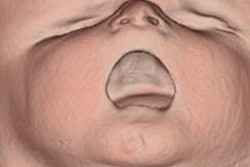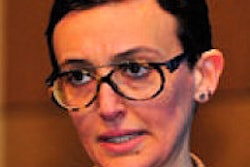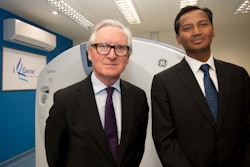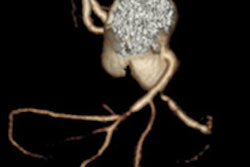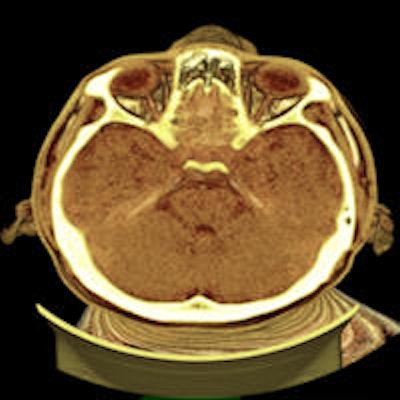
Forensic imaging in Europe has received a welcome boost from the Malaysian company iGene, part of the Infovalley group. The firm is pushing ahead with ambitious plans for several new U.K. digital autopsy facilities that will use a 64-slice CT scanner and visualization chamber, 3D imaging software, and automated workflow systems.
The first unit is due to open later in October, and will be located in an extension to Sheffield's Medico-Legal Center, at which the city council mortuary and coroner's services are already based. The CT slices will range from 0.625 mm to 0.5 mm, as higher spatial resolution is required. A whole-body scan of 170 cm in length, for example, will generate around 3,400 slices that will be transferred to a high-performance computing server and undergo 3D rendering of DICOM and grayscale multiplanar images at a 3D workstation. Specific protocols will enable visualization of the body's outer layers that contain hair and skin.
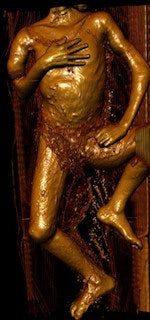
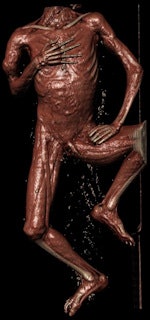
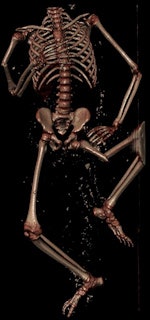 A 15-year-old boy was fatally injured in a landslide that destroyed a building. Left: External deformity of right upper limb corresponding to underlying compound fracture of the humerus. External deformity of left lower limb, corresponding to underlying compound fracture of the femur. Middle: Digital autopsy shows muscle lacerations. Right: Digital autopsy shows bone fractures. All images courtesy of Dr. Pramod Bagali and Matt Chandran.
A 15-year-old boy was fatally injured in a landslide that destroyed a building. Left: External deformity of right upper limb corresponding to underlying compound fracture of the humerus. External deformity of left lower limb, corresponding to underlying compound fracture of the femur. Middle: Digital autopsy shows muscle lacerations. Right: Digital autopsy shows bone fractures. All images courtesy of Dr. Pramod Bagali and Matt Chandran."It is just as important for forensic pathologists to visualize the outer layers as the internal layers as this is where bruises and abrasions can be found. In criminal cases, this might be the entry and exit wounds of bullets, knives, or in the case of alleged suicide, where the small cuts over the wrist leading to extensive hemorrhaging would cause death," explained iGene's Chief Operations Officer and Lead Forensic Pathologist Dr. Pramod Bagali.
Although toxicology and biopsy will still be required in some cases, future developments in MR spectroscopy may make blood draws for verifying poisoning cases a thing of the past, Bagali added.
Digital autopsy using multislice CT is the answer to many of the problems posed by traditional autopsy, notably speeding up the process from registration of the body through to the final postmortem report, according to entrepreneur and iGene Founder Matt Chandran. In addition, minimal invasion tends to cause less grief to bereaved families, and also keeps within the moral constraints of certain faiths, he noted.
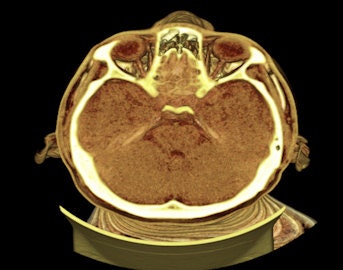 This image demonstrates the capabilities of digital autopsy in the head and neck. In cases of shaken baby syndrome, retrobulbar hemorrhages can be diagnosed.
This image demonstrates the capabilities of digital autopsy in the head and neck. In cases of shaken baby syndrome, retrobulbar hemorrhages can be diagnosed.Chandran first conceived the idea of commercializing digital autopsy in 2003. The idea eventually resulted in the first commercial application in 2008 and a contract for the first service level digital facility at the General Hospital of Kuala Lumpur, which opened in April 2010. This facility is still maintained by iGene, which also trains the facility's staff, but is owned and run by the government of Malaysia after it invested a little more than 15.2 million euros in the initiative.
The iGene-owned private Sheffield facility will flagship other such centers that the company plans to develop across the U.K., including facilities at Bradford by the end of this year and also at Sheffield Children's Hospital, as well as at centers in Bristol, Hammersmith and Fulham, and Greenwich, London, by June 2014, depending on final building authorization from local governments.
The facility at Sheffield Children's Hospital will also use MRI data in newborns and children younger than 10 in its digital autopsy process. The use of MRI as a viable alternative to surgical autopsy in newborns and fetuses has been documented, most recently in the Lancet in July (20 July 2013, Vol. 382:9888, pp. 223-233), and the fusion of CT and MRI digital autopsy will make Sheffield a center of excellence, according to iGene. Research continues on how best to combine the data extracted from each modality for optimal results.
"This new fully digital forensic ecosystem will change the way postmortem autopsy is conducted and the way the public perceives postmortems. At present, much time, effort, and money are spent on traditional autopsy, and after sometimes months of work, a short discussion will yield a brief verdict that the next of kin must accept. It is not transparent, it is not visual, and it is not appreciated by nonmedical family members," Chandran said. "This new generation of forensic autopsy in the U.K. will also mean that when social justice is served, it is served well."
iGene's Infopsy, an end-to-end solution for digital autopsy, controls workflow as information entered into the system triggers the next part of the autopsy route -- and when imaging is required, the correct protocol. The process culminates in a high-definition multimedia report.
 Visualization of the vertebral column, which is not straightforward in a classical autopsy because dissection of the spine is time-consuming and involves the sawing of the spinous process of vertebral bodies.
Visualization of the vertebral column, which is not straightforward in a classical autopsy because dissection of the spine is time-consuming and involves the sawing of the spinous process of vertebral bodies.The scanning module, iDASS (Digital Autopsy Software Systems), lies at the heart of the process, enabling pathologists to visualize and analyze a complete 3D image of a body in near real-time. In expected and nonsuspicious deaths in the elderly, for example, the system will allow proper documentation of a death, even if imaging is not required, while at the other end of the scale, the system can cater for a full criminal investigation forensic autopsy, complete with 3D panoramic views of the crime scene, according to Chandran.
"In Malaysia, iDASS was able to quickly reveal three bullets in an advanced decomposed body that had been illegally buried and then exhumed, without even the need to take it out of the radiolucent body bag. The classic autopsy was only needed to retrieve the bullets rather than to find them, which, otherwise, would have been extremely difficult as the body had been buried in gravel with a high metallic content and therefore bleeped all over when examined by metal detector," said Bagali, who will be present as a trainer in Sheffield during the initial weeks following the facility's official launch at the World Islamic Economic Forum in London at the end of October.
The input of radiologists will be sought for interpretation of certain images, according to Bagali, but he pointed to the importance of radiologists having forensic pathology training, just as the pathologists involved in digital autopsy should be trained in radiology. This cross-skill training ensures appropriate interpretation of images.
"For example, the natural process of livor mortis, which is blood accumulation in parts of the body once the circulation has stopped, depends on the body's position. It would appear on the back if the body is prone face up, or in the lower limbs if suspended, as in a hanging. This postmortem staining might be wrongly attributed to pneumonia of the lungs, or trauma to the lower limbs, if the position is not correlated," Bagali said. "For natural deaths, a radiologist may be better placed to interpret pathological findings visualized in the organs as cause of death, to complement the pathologist's findings."
The digital autopsy will remain under the lead of the pathologist, with radiographers, or technicians present to carry out scans.
A team of 25 iGene pathologists, radiographers, and several radiologists is to be recruited for operations in the U.K. during the next 12 months. Sheffield will constitute a team of five that will include forensic pathologists, radiologists, and technicians.
Besides providing services to fee-paying clients, the facilities will also serve as cross-skills training centers, a role that underlines Chandran's belief in the digital autopsy revolution.
The company has been involved in such training for more than three years in Malaysia, the United Arab Emirates, Saudi Arabia, and Singapore, as well as competency training at the Queen Mary School of Medicine, and the Academy of Forensic Medical Sciences in the U.K.
"Our goal is to train as many people as possible in digital autopsy with a view to building similar facilities in these countries. Over a period of time, we believe that pathologists from the respective countries will be able to handle the cases with the least amount of support from our team," Chandran said.
Objections to full digital autopsy are varied and include the opinion that some disease-related causes of death cannot be visualized in images. Other obstacles include the huge financial investment such facilities require. For its part, iGene will be investing 57 million euros in its U.K. project, a figure that some might argue puts digital autopsy out of reach for many European governments aspiring to include it in mainstream health services. A further 19 million euros is slated for expansion in Malaysia.
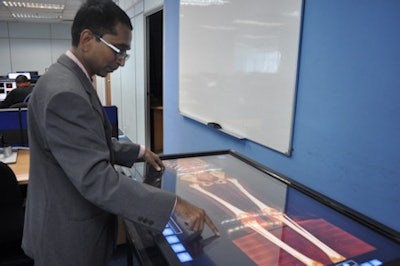 Dr. Pramod Bagali conducts a 3D digital autopsy derived from 64-slice CT. Thickness of slices ranges from 0.625 mm to 0.9 mm.
Dr. Pramod Bagali conducts a 3D digital autopsy derived from 64-slice CT. Thickness of slices ranges from 0.625 mm to 0.9 mm."The U.K. government is quick to recognize that this sort of technology will transform the economy and so it is being bullish about this initiative. We have the best support from the highest level of U.K. government and, except for money which we didn't expect anyway, have been given a full range of support required for running a business," Chandran said.
Moreover, reforms outlined in the Coroners and Justice Act 2009 that were under consultation until April were implemented in July of this year.
A section of the reforms paves the way for alternative methods to the classic invasive autopsy, making the potential inclusion of digital postmortems in the mainstream judicio-health arena more foreseeable. For now, iGene's U.K. services will be paid for only by private clients at 500 pounds (590 euros) per case. It is expected that the Sheffield facility will, like the one in Kuala Lumpur, break even after two to three years.
"Our experience in Malaysia tells us that 70% of routine cases can be solved using digital autopsy, and these include road traffic accidents, homicide or death from gunshot wounds, and other accidental or natural deaths," Chandran said. "Other research groups using different systems that include some form of imaging in Switzerland, Oxford, and London have reached the same conclusion."
Bagali and Chandran agree the new technology will optimize workflow and means that full anatomical surgical autopsy could be reserved for cases in which cause of death was too subtle to be addressed by digital autopsy alone.
"The process must be clear to the judiciary, next of kin, and, when relevant, investigators, who need to see in a clear, highly visual way how the findings were reached," Chandran said. "It brings discipline to forensic investigation and the way the judiciary sees it. It makes a death certificate meaningful."
More information can be found at www.mydigitalautopsy.com.




